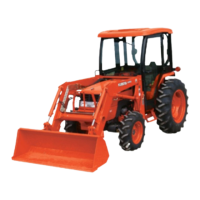
Do you have a question about the Kubota MX5000 and is the answer not in the manual?
| Transmission | 8-speed synchro-shuttle |
|---|---|
| PTO Power | 42 hp |
| Weight | 3, 197 lbs |
| Type | Utility tractor |
| Fuel Type | Diesel |
| Hydraulic System | Open center |
| 3-Point Hitch | Category I |
| Drive | 4WD |
| Fuel Tank Capacity | 13.5 gallons |
General safety warnings and symbols used throughout the manual.
Preparatory safety steps and guidelines before performing any maintenance or repair work.
Covers safety during starting, working, avoiding fires, ventilation, burns, and fluid disposal.
Identification and meaning of safety decals affixed to the machine.
Locating and identifying key serial and model numbers on the tractor.
Guidelines for safe handling of parts and performing assembly procedures.
Safe practices for working with electrical system components and wiring.
Information and procedures related to the tractor's battery.
Details on the tractor's fuse system and their function.
Information regarding electrical connectors used in the tractor's wiring.
Instructions for using a circuit tester for diagnostic purposes.
Specifications and types of fluids required for the tractor's operation.
Specifications for tightening various screws, bolts, and nuts.
Overview of scheduled maintenance tasks and intervals for regular service.
Routine checks to be performed daily on the tractor.
Maintenance items to check after the first 50 hours of operation.
Maintenance items to check every 100 hours of operation.
Maintenance items to check every 200 hours of operation.
Maintenance items to check every 400 hours of operation.
Maintenance items to check every 600 hours of operation.
Maintenance items to check every 800 hours of operation.
Maintenance items to check every 1500 hours of operation.
Maintenance items to check every 3000 hours of operation.
Maintenance items to check annually.
Maintenance items to check every two years.
Miscellaneous maintenance and checks not categorized elsewhere.
Listing and description of specialized tools for maintenance and repair.
Information on different types of tires available for the tractor.
Procedures for adjusting front and rear wheel treads.
Specifications and details regarding the wheel hubs.
Recommended tire inflation pressures for optimal performance and safety.
Information on using liquid ballast in tires.
Guidelines on using implements with the tractor.
Common engine problems, probable causes, and solutions.
Detailed technical specifications and tolerances for engine components.
Torque values for engine fasteners to ensure proper assembly.
Procedures for removing the engine from the tractor.
Information on engine oil pressure, rotor lobe clearance, and lubrication.
Details on fan belt tension, thermostat operation, and radiator cap testing.
Procedures for checking and servicing the injection pump, delivery valve, and nozzle.
Structure and linkage mechanism of the main clutch.
Details on PTO clutch shift linkage, structure, and oil flow.
Common clutch issues, probable causes, and solutions.
Technical specifications for clutch components.
Torque values for clutch assembly fasteners.
Procedures for inspecting, disassembling, and servicing clutch components.
Overview of the transmission system's mechanical layout.
Common transmission problems, probable causes, and solutions.
Technical specifications for transmission components.
Torque values for transmission fasteners.
Procedures for servicing clutch and mid cases.
Procedures for disassembling and servicing the transmission case.
Diagram and description of the rear axle assembly.
Common rear axle noise issues and solutions.
Torque values for rear axle mounting fasteners.
Procedures for separating the rear axle from the brake case.
Procedures for disassembling the rear axle components.
Diagram of the brake system's mechanical components.
Common brake issues, probable causes, and solutions.
Technical specifications for brake components.
Torque values for brake assembly fasteners.
Procedures for checking and servicing the brake pedal.
Procedures for disassembling and servicing the brake case.
Diagrams of the 2WD and 4WD front axle assemblies.
Camber, kingpin, caster, and toe-in adjustments for proper wheel alignment.
Diagrams illustrating the steering linkage.
Schematic showing the oil flow in the steering system.
Details on steering cylinder configurations (2WD/4WD).
Common steering system problems, their causes, and solutions.
Technical specifications for steering system components.
Torque values for steering assembly fasteners.
Procedures for checking and servicing the power steering pump.
Procedures for adjusting and servicing the control linkages.
Procedures for checking and servicing the relief valve.
Procedures for checking and servicing the cylinder safety valve.
Disassembly and servicing of hydraulic cylinder and control valve.
Schematic diagram of the tractor's hydraulic system.
Diagram of the hydraulic system components and their arrangement.
Specific circuit diagram for the three-point hitch hydraulics.
Common hydraulic system issues, probable causes, and solutions.
Technical specifications for hydraulic system components.
Torque values for hydraulic system fasteners.
Procedures for checking and servicing the hydraulic pump.
Procedures for adjusting and servicing control linkages.
Procedures for checking and servicing the relief valve.
Procedures for checking and servicing the cylinder safety valve.
Electrical schematic and wiring color codes.
Common electrical problems, their causes, and solutions.
Technical specifications for electrical components.
Torque values for electrical system fasteners.
Procedures for checking battery voltage and specific gravity.
Checking and testing the main switch and starter motor.
Procedures for checking and servicing the alternator.
Checking continuity and voltage for lights and switches.
Checking engine oil pressure and charge lamps.
Checking fuel level and coolant temperature gauges.